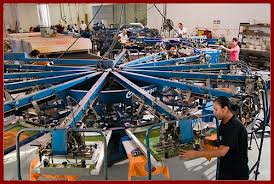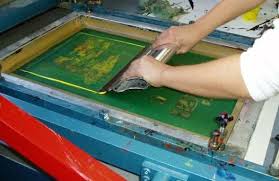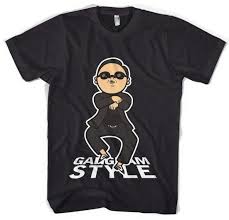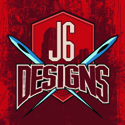How you decide to get your apparel printed is one of the most important decisions you will have to make. The good news is that there is a definite right and wrong way to go about this, and my advice in this area will therefore be much more straight forward and univocal than it has been on previous topics.
Why is the production process so important? The answer is that production is of key importance because it determines a lot of the outcomes of your endeavor. On the financial side, production will end up being one of the higher ongoing overhead expenses you have to deal with. Even though it may be an expense of lesser magnitude than say the cost to build a website or pay for artwork, it is an aspect of the business that will become significantly more important down the road as you start to sell more product.
Of greater relevance to our discussion on how to start an apparel line, decisions you make about production from the beginning will determine the kind of reputation you establish for your brand – and you usually only get one opportunity to make a good impression. Production decisions are directly related to your brand reputation because the choices you make about production determine the quality of your product and your capacity to develop an inventory that is responsive to your customer’s needs.
In this section we will discuss some ways to develop a production strategy that is right for you. I run an apparel printing company, so I am especially knowledgeable about this aspect of the business and will be able to provide insight that can give you the competitive edge needed to compete in a saturated market. Don’t worry, I won’t bore you with tedious or technical details of production processes; this discussion will be limited to those things that are most essential to starting and running a successful apparel line.
Production: Things You Don’t Have to Worry About
When it comes to production there are things you do have to worry about and things you don’t have to worry about. Right now I’ll just run through some of the things you don’t have to worry about.
Great news! You don’t actually have to worry about production at all! The economic laws of comparative advantage and division of labor mean that there are other organizations that can take care of production at a much lower cost and higher quality than you can probably do for yourself. In fact, in all of my years of experience I have only come across one case where the people starting the apparel line were able to print the apparel themselves, and that was a highly exceptional case wherein the people starting the apparel line were already running a printing company at the time. Chances are very high that you don’t actually fall into that category and will need to find a way to outsource the production capacities of your apparel line.
Some clarification should be made on what exactly is meant when I say you don’t have to worry about production at all. This certainly does not mean to google a printer and delegate all production responsibilities to the one at the top of the search results list. What is meant by the statement is that you don’t have to go out and learn the ins and outs of the printing or embroidery process before you are ready to sell your apparel. Production requires expensive equipment along with specialized knowledge and skills that would take you years to develop from scratch. Even though you should educate yourself on the terms and have a familiarity with the different printing and embroidery processes, you don’t need to worry about actually knowing enough about it to do it yourself.
We’ll talk about finding the right printer in the next section. For now let’s assume you have found the right production resource. If the printer you’re dealing with is good, they will provide you with a lot of guidance on the best way to get something printed to achieve your desired result. I would not trust a printer to be an affordable source of graphic designing services, but the right printer will be a trusted partner when it comes to offering advice on the method of production. If you need t-shirts for example, there are several alternative methods available for printing (basic spot color, four color process, direct-to-garment, heat transfer), and selecting the right printing process depends a lot on the variables involved in a given project. A good printer will take all variables into consideration and educate you on the options available.
Like anything else in this world, you always risk running into the printer that is going to try to take advantage of your lack of knowledge and either withhold useful info from you or blatantly lie. The best thing to do to avoid this situation is to have an interview process and ask a lot of questions before agreeing to have any work done. A good printer will not only answer your question, they will be able to provide you with information on all the pros and cons of your printing alternatives. They should be knowledgeable and eager to help you develop a better understanding of the process. If they are impatient with your questions, then they either don’t have enough time to properly deal with your needs, or they are trying to keep you from fully understanding how effectively your money will be spent. In either case, they aren’t the right printer for you.
Finding the right production resource will mean that you don’t have to spend the time developing a working knowledge of the production process itself. However, you will need to know enough that you can ask the right questions in the interview stage. You will want to ask general questions about the best method to print a specific design, but you will also want to know enough to follow up the general questions with more specific ones to show you have done some research and test the knowledge of the printer you are interviewing.
Here at J6 Designs (the apparel printing company I run), we have been in this business for over a decade and have learned that the best customers are the ones that we take the time to inform and educate on the production process. It has been our experience that results are consistently better when the customer is aware of all their printing or embroidery options and given advice on the one that suites their needs best. This approach requires a lot of consulting to begin with, but most customers appreciate our efforts and are loyal because they can’t find the same level of commitment to full transparency and customer education anywhere else.
There is a lot of stuff you don’t have to worry about when it comes to production, but there is a catch: you have to find the right printer. Since finding the right printer is something you do have to worry about, it will be covered in more detail in the next section.
Production: Things You Do Need To Worry About
When it comes to finding the right source for your printing or embroidery, there are three general qualities to look for: quality standards, pricing, and customer service.
The vendor you choose to print or embroider your apparel will directly determine the quality of the product you are going to be able to offer. If you choose the wrong source for your production and have them print 500 items for your big launch event, there is nothing you can do to go back and repair the damaged reputation you created by selling a low quality product. Even though you can’t have absolute control over the production standards unless you are doing the printing yourself, there are things you can do in the vendor selection process to reasonably insure you will get a product you can be proud to sell.
To get quality work done, you need to find a printer that has an established reputation in the apparel industry. A vendor that has been in business for a long time should be especially preferred. Anyone not in the business for at least three years is a little questionable because they have yet to establish a reputation or prove they can be successful in the long-term. Successful apparel printers have been in the business at least five years and have proven they can provide a quality product at a competitive rate. Years in business is therefore the first thing to look for when evaluating the alternatives to determine the capacity for delivering a quality product.
Another thing to look for that will help you avoid printers that consistently provide low quality services are the customer reviews. In the internet age, these are especially easy to find. Do a little research to see what people are saying, or simply ask around to see what friends or acquaintances have to say. Every company is going to have those few outspoken customers that had a bad experience, but those types of reviews should be balanced by more positive reviews. In other words, you should be able to find more positive than negative.
If you find a vendor you like but still have uncertainty about their quality, just order a small run of prints so you can test the quality without having to commit a large amount of financial resources. If the small run comes out bad, don’t let the vendor convince you it was a one-time mistake that won’t happen again; just move on to the next printer. A good printer will be able to consistently deliver an exemplary product without excuses. Here at J6 Designs, all product is put through a quality control process, and any items not complying to the standards are immediately reprinted. If the printer has delivered you a poor product from the get-go, this is usually indicative of quality issues that will only become more apparent and problematic in the future.
Not only are you looking for a vendor that consistently provides quality printed apparel, you also need them to provide it at the right price. The right price will vary depending on your particular circumstance. You will need to calculate your running overhead to determine how much you can pay for product and still be profitable.
 Unfortunately, I see too many people making simplified calculations that do not include large overhead expenses like advertisement or website maintenance costs. Once you have underestimated how much money you spend just to be in business, you will usually overestimate how much money is available to cover production costs and negotiate a rate with your vendor that renders your apparel line unprofitable.
Unfortunately, I see too many people making simplified calculations that do not include large overhead expenses like advertisement or website maintenance costs. Once you have underestimated how much money you spend just to be in business, you will usually overestimate how much money is available to cover production costs and negotiate a rate with your vendor that renders your apparel line unprofitable.
The other point to make about determining how much to spend on production costs is that you don’t’ want your business to be simply profitable; you want to make sure that it is lucrative enough for you to invest a significant amount of that profit in developing and growing the apparel line. The key to having money to reinvest is making sure you have put in the effort to properly negotiate the lowest possible rate for production costs. I’ve seen far too many people go out of business after a year because they paid too much for production and never had the money to capitalize on growth opportunities.
Most people end up paying too much because they are paying retail prices for the production of their apparel. This is easily avoided by confronting the vendor about the issue if you see your prices are just as high as the retail prices they are advertising. When interviewing vendors, make sure to as for their broker price list and get the agreed rate written down for future reference in case there is a dispute. As a rule of thumb: anything that has to do with production, from pricing to artwork proofs, should be written down in one form or another so you have a record you can go back to determine fault in the case of an expensive error.
A brief tangent on the importance of making sure there is a written record of all your dealings with the vendor in the production process is in order here. Expensive errors can occur even to the best of printers, so it is important to have your back covered and are able to reasonable show the vendor was at fault in a given case. If you can show that the vendor was at fault then they have to go back and fix their mistake at no additional cost to you; if you are unable to show this, the vendor has the prerogative to charge you for the fix, and this can get real expensive if new apparel product has to be purchased. Not only do you want things written down, you also want to make sure that the content of what you write down is clear and accurate. Try to avoid writing instructions that are equivocal or incomplete. Always be as descriptive as possible and include details, even if you don’t think they are especially important.
The final quality to look for when making evaluations on vendors is the level of customer support and accommodation they offer. This is an important aspect that is often overlooked initially, because it doesn’t seem important in comparison to the quality and pricing of the product they offer. Even though this may not be important in the short-term, you will find it is essential for the long-term success of your apparel line to have a very close relationship with your vendor.
There are times when you will need a favor to meet a deadline, and you want a vendor that is going to break production protocol a little to get the job done within your turnaround requirement. There are a lot of things you probably don’t know about the production process and you will need to rely on the vendor to volunteer advice in certain cases, even if it is inconvenient or less profitable to them. You want to make sure that your vendor believes in what you are doing and understands that your success is their success. You need to convince them you are serious about what you are doing so they know you are a long-term investment and not just a one-hit-wonder that’s only good for one order.
This kind of trusting business relationship is something that can only develop with time, but there are things you need to do from the start to get things headed down the right path. First, make sure to buy your own apparel product instead of asking the vendor to provide it. Having your own apparel product shows that you have already made a significant investment in the project and have enough skin in the game to see it through to the end. From the vendor’s perspective, it is actually very risky to buy product up front; and as a broker with a resale license you should be sourcing the product so you don’t have to pay a markup.
Another thing you can do to get off on the right foot with your printer of choice is to have everything well prepared when you place an order to show that you genuinely care about the quality and accuracy of the outcome. Too many people are sloppy and careless about their approach, and this has a way of leaving people particularly uninspired by what you are doing. Remember, you want to be the person that people want to buy apparel from, and this is especially true in the case of your printer. He/she is a resource you will need to rely on to go out of the way to accommodate and advise you.
The printer won’t go that extra mile if they don’t think you are motivated and passionate about what you are doing.
What Size of Printer Should I Look For?
This is one of the most frequently asked questions I get in this industry. Unfortunately there is no single answer to that question because it depends a lot on where you are and what your needs are at the time. I’ll outline the basics and discuss the pros and cons so you can get a better idea of where you fall.
There are three options you will have to choose between: garage printer, medium or small printer, and large corporate printer.
The garage printer is just what it sounds like. It’s a guy or gal in their home garage printing apparel on a manual to supplement their income. The prices you will get from a garage printer should be unbeatable because they have no overhead to pay for — just their time and whatever investment they made for equipment. Even though the prices will be great, the garage printer will be highly limited in their capacity to print large numbers, and they won’t be the type of dedicated partner you need for the long-term. They only screen print to supplement their income, which means their job is the number one priority, not the services they provide for you. They will print your apparel when they can find the time in their busy schedule, and this isn’t going to work once you start selling product and run low on inventory.
Despite the drawbacks, the garage printer is a great place to start if you are operating on a tight budget and have not yet filled a lot of orders. The prices they offer will make the initial investment for product and printing more affordable, and you can use the money you save for advertising to increase the profile of your presence in the apparel market.
I would only go to a garage printer to start out if you are forced to by budget constraints. The problem is that your apparel line is going to take off and you are going to have to go out and find small or medium size printing business that can handle the increasing magnitude of orders you will require for inventory. This transition will require a lot of time and energy and could produce inconsistencies in the quality or style of your product – it should be avoided if at all possible.
If you have the money, I would suggest finding a professional apparel printing operation to work with from the outset, instead of starting with the garage printer and having to make a costly transition later.
The small and medium size printers will be able to offer you the quantities and reliability the garage printer can’t. They are a business whose existence depends on their ability to successfully compete for clients like yourself; so unlike the garage printer who just wants to supplement income, you are the number one priority. You will have to pay a little more for their services, but it is well worth the investment because you are building a relationship with a printer who can actually provide you what you need to succeed for the long-term.
The small and medium size printers usually have minimum item requirements on all orders. What this usually means is that they won’t accept any orders that are under 20-30 items. This minimum is going to be even higher if you go with a large corporate printer or order from overseas. Usually you will be required by a large printer to place orders of 500 items or more, and when you are starting out this can be prohibitively expensive. I highly suggest you feel out the market and see which designs sell before placing orders that large. The medium size printer is ideal for this because you won’t be out thousands of dollars if a particular design doesn’t sell well.
The advantage of going to a large printer is that the rate you pay per item will be somewhat lower than if you were to get it printed at a local shop. However, the restrictions on order volume make it prohibitively expensive to place orders with them when you are first starting out.
Let’s say you find a garage printer because you don’t want to make a large initial investment for product. However garage printers use smaller and less expensive equipment and may not be able to print the amount of colors at the quality you require. In this case you need to decide whether you are going to modify the artwork or pay more and go to a professional printer. So even though consideration of budget constraints may dictate you find a garage printer, the integrity of your artwork and quality of product may require you go to a larger printer.
Decisions like this are ones that only you can make for yourself. In the end it is a judgment call based on the particularity of your circumstances at a given time. Each of the three types of printers have their strengths and weaknesses we have just discussed; now it’s up to you to make the decision about which is the most appropriate for you given your limitations and requirements.











